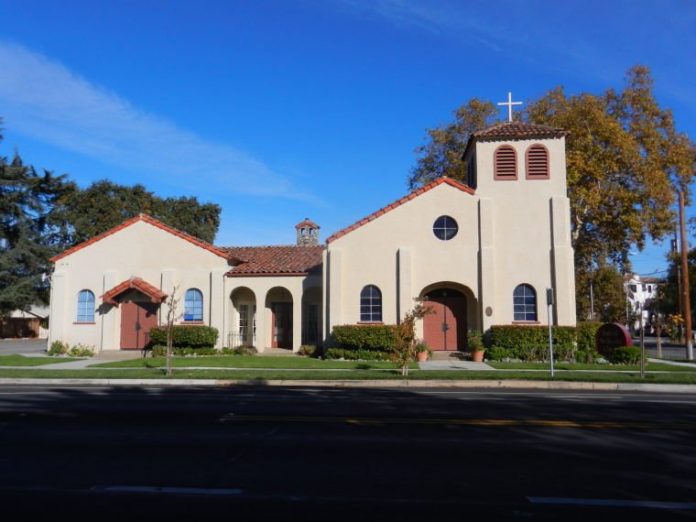
The first church of any denomination organized in Gilroy (known as Pleasant Valley back then) held its first meeting on June 4, 1853. The church grew and eventually another Methodist church was built, so that before the Civil War, Gilroy had both a north and south Methodist Church.
During WWI, the entire Gilroy Methodist family decided to unite, rather than remain separate and competing enterprises. On March 23, 1917, it was resolved that the 1871 church building would be added to the north Methodist Episcopal Church. At great cost, the smaller church building was moved and added to the back of the larger building, and both were remodeled. It was a new day.
Imagine their devastation when the grand new building was completely destroyed by fire.
On Sunday morning, Nov. 13, 1938, a furnace exploded, and fire quickly destroyed the building that stood as a symbol of unification in Gilroy. Members stood by helplessly watching the walls of their church crumple to the ground. More than 2,000 people from the community were drawn out of their homes to watch the fire.
Although everything in the church building was a loss, the hard-working firefighters that day were credited with keeping the fire from spreading to nearby homes. Firefighter Horace Willson, 40, suffered first-degree burns of his forehead and cheeks, and firefighter Jim Mercer had to be treated for smoke inhalation.
Volunteer firefighter Russell M. Heck, co-owner of the “Busy Bee” tavern on Monterey Street, was overcome by smoke inhalation. He died less than two hours after being taken to Wheeler Hospital. He was 36, a husband and the father of two children, Marjory, 8, and Kenneth, 4.
As the church members watched the fire that morning, surprisingly, there were no thoughts of calling it quits. Rather, a serious determination rose in their hearts that “We shall build again.” Church members spent weeks digging out the ruin of the old buildings as soon as the embers cooled.
The pastor of the church at the time, Rev. Ezelle Cox, described the process of rebuilding of the church with all volunteer labor in his journal (which was returned to Gilroy by his daughter Carol last fall after 75 years): “The ground breaking ceremony with Dr. Palmquist was held on the afternoon of January 1, 1939…on a rainy day the foundation was laid out. John Wentworth and Roger and Gene did the grading. Delbert and his truck were on the job to finish the excavating. Carpenters, under the direction of Fire Chief Ray Shields, hurried the forms so we could use men on Feb. 22 to help with the pouring.
William Radtke loaned his big mixer and a big crew started off the actual building on that day. At noon the women were on the job with another big meal. Work progressed almost miraculously with practically no time lost by weather or lack of material.”
“From Nov. 13 to June 11, it was one record of cooperation of organizations, individuals, and churches. The first expression of community cooperation that set the pace was the benefit held by the Catholic Ladies Aid early in December from which they presented us with a check for $108.60. The other Churches and organizations followed in the same fine spirit with fine gifts.”
Creative church members sold rusty nails taken from the demolished building that were placed inside little pamphlets showing the drawing of the future church on the front.
The pamphlet with the nail read: “For eight and sixty years, without reward, I’ve faithfully served in the House of the Lord; Please give for me a Quarter—OR MORE, and I will thankfully rest within your door.”
Response from the community was tremendous, and the church was dedicated on June 11, 1939, barely more than six months after the January 1 groundbreaking, a testament to the Gilroy record of wonderful cooperation in working together, backed by a united, hardworking and courageous congregation and community spirit.
“Practically all organizations and churches here have cooperated wholeheartedly in providing us with a new home,” Rev. Cox said.
The San Jose Mercury Herald wrote on June 19, 1939, of the dedication of the new building that had risen from the ashes and how deeply moving it was: “It was not so much the beauty of the dignified, simple service so much as the evidence of wonderful, whole-hearted cooperation on the part of pastors, people and the community which had made it possible for Dr. H.R. Chesbro, chairman of the trustees, to present this modern edifice, free from debt, for dedication.”
“We did the only thing we could,” wrote Helen Glandon, a longtime member of the church who returned to Gilroy that day, as did many from out of town, to be there for that historic moment. “We sang, ‘Praise God from whom all blessings flow’ as best we could with hearts overflowing.’”
Helen Glandon sounds like she could be one of the present-day church members, and Dr. Chesbro sounds like the current hardworking head trustee, Hal Leister. The legacy of these fine people in our history lives on in so many ways today in the very walls of the church, in the very heart of the church, in the very spirit of our community!












